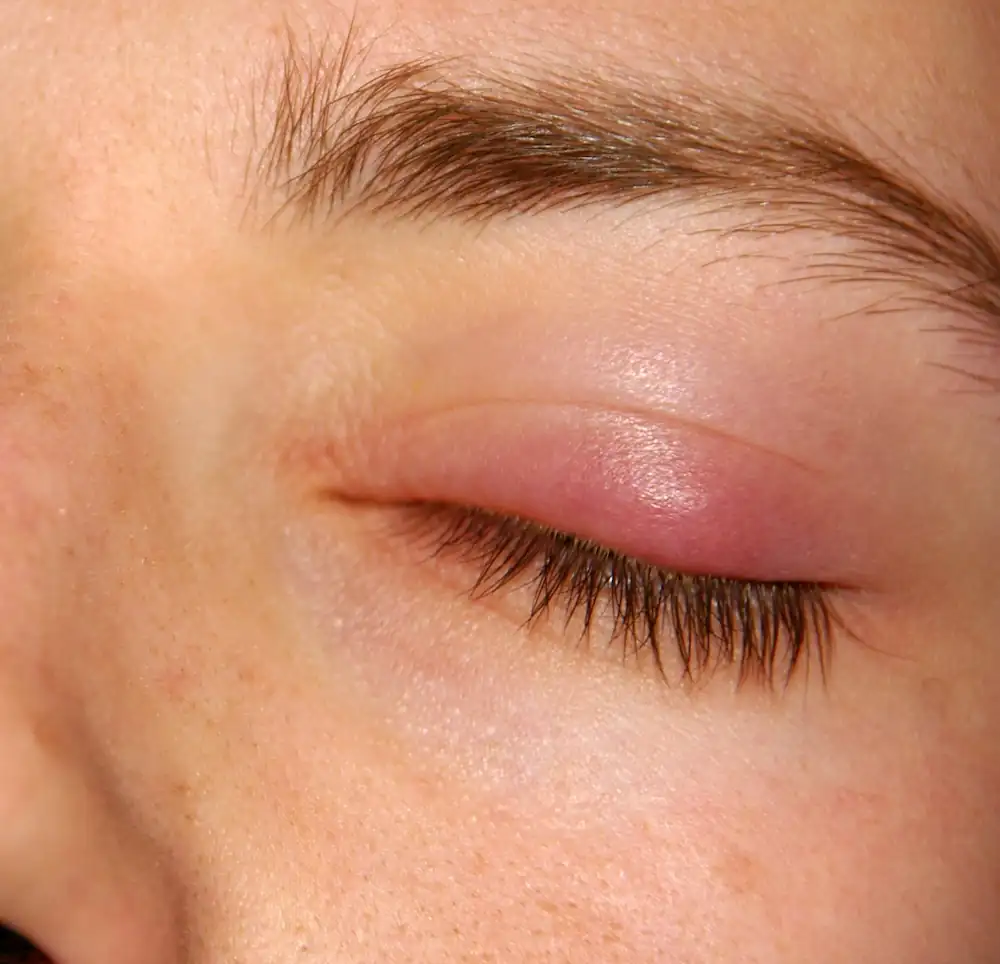◉ What is a chalazion ?
A chalazion is a small bump in the eyelid caused by the blockage of a tiny gland, Meibomian gland, responsible for secreting the lipid phase of the tear film.
It seems to affect men and women equally. Chalazion develops in adults between the ages of 30 and 50, it is not common in children, but it can happen.
During an obstruction of one of the glands, undrained secretions slowly accumulate within the gland and this leads to acute inflammation accompanied by redness of the surrounding skin and pain.
After a while, the chalazion is no longer painful and can go away without treatment. However, see an eye doctor if it becomes bothersome, repetitive, or blocks your vision.

Chalazion
◉ Symptoms
More than one chalazion can occur in an eyelid at the same time. Both eyes and both upper and lower eyelids may be affected may be affected.
Symptoms can include:
- A bump on the eyelid, sometimes becoming red and swollen.
- Tearing.
- Mild eye irritation.
- Blurred vision, if the chalazion is large enough to press on the eyeball.
- Rarely, a fully swollen eyelid.
After a few days, the pain usually subsides and remains a lump or lump.
Note: A chalazion may develop and you may not see any symptoms.
◉ Why do we get chalazions?
A chalazion is caused by a blockage in one of the tiny meibomian glands of the upper and/or lower eyelids.
These glands produce oil that mixes with your tears to moisten and protect your eyes.
If the oil becomes too thick or the glands are blocked due to inflammation, you may have a chalazion.
◉ What are the risk factors?
Various factors favor the irritation of the Meibomian glands and the appearance of a chalazion:
- Rosacea (a skin condition that causes redness and acne).
- Blepharitis (inflammation of the eyelids)
- Seborrheic dermatitis (red, dry, scaly, itchy skin).
- Allergies, diabetes.
- Certain bacterial (tuberculosis), parasitic (leishmaniasis) or viral infections.
- High concentration of fat in the blood.
- Air pollution.
- The habit of leaving eye makeup on overnight or using old or expired cosmetics.
◉ Chalazion VS Stye
Sometimes it can be difficult to tell the difference between a stye and a chalazion, however there are differences between these two lesions :
Chalazion
- It is usually found in the thickness of the eyelid.
- Often larger than the stye.
- Generally it is not painful
- The chalazion is a non-infectious inflammation the chalazion can become infected later.
Stye
- The stye develops on the edge of the eyelid, at the root of the eyelashes.
- Very painful.
- Usually caused by an infected eyelash root.
◉ Diagnosis of chalazion
The diagnosis of a chalazion is usually clinical. If the history and examination are consistent, no further workup is needed.
Examination of the eyelid reveals a more or less large cyst. It can be red and painful when it is in the inflammatory phase.
◉ Chalazion treatment
Most chalazions go away on their own within days to weeks without treatment, but sometimes they persist for months.
- DO NOT push or squeeze the chalazio
- Good Hygiene: Wash your hands thoroughly before and after touching your eyes.
- Massage: A gentle massage of the eyelids and possibly the use of baby shampoo on the eyelids can also be effective.
- Hot compresses: Apply sterile hot water compresses for 10 to 15 minutes (repeat 3 to 4 times a day for several days).
- Medical treatments: Consist of applying anti-inflammatory ointments. Antibiotics are not routinely needed as this is an inflammatory disease.
- Surgical treatment: A minor operation is an option if the lump does not go away or if it causes persistent bothersome symptoms.
Note : If an infectious cause is suspected, tetracyclines are the antibiotics of choice.
◉ Prevention
According to American Association for Pediatric Ophthalmology & Strabismus : A consistent daily regimen of eyelid scrub using baby shampoo or pre-moistened eyelid cleansing wipes can reduce
the risks of developing new chalazions. This is particularly useful in case of blepharitis.
Using omega-3s and/or flaxseed oil by mouth can also reduce eyelid inflammation.
According to Sorbonne St Michel Ophthalmological Center in Paris:
A surgical cure does not prevent the appearance of new chalazions at the expense of other glands. In the event of an underlying chronic pathology predisposing to chalazions, you are advised to continue eyelid care for life to prevent the reappearance of new chalazions.
🏿 Frequently Asked Questions
Q: How long does the chalazion last?
A: With good housekeeping, a chalazion should heal within a week. If left untreated, the chalazion can take four to six weeks to heal.
Q: Can I squeeze a chalazion?
A: It is important that you never try to pop or squeeze a chalazion, as this may worsen the inflammatory reaction.
Q: Is the chalazion contagious?
A: The chalazion is not contagious, the mechanism is most often inflammatory.
Q: When should a chalazion be operated on?
A: If a chalazion persists for more than one to two months, surgical incision and drainage may be required.
Q: Does a chalazion go away on its own?
A: Yes, most often the chalazion goes away on its own.
